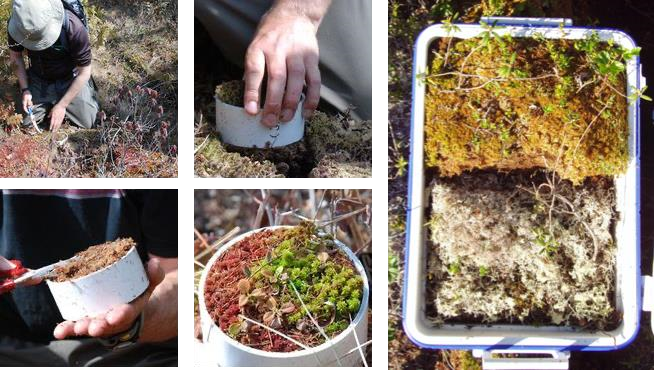8.2 Sampling Peat
Sampling soil for hydrophysical properties requires that the soil structure remains undisturbed. Consequently, peat soils require special considerations when sampling for hydrophysical properties because peat is a plastic, elastic, and compressible media that makes extracting undisturbed and intact samples difficult. This is particularly true for the easily disturbed delicate near surface mosses.
The easiest method for removing intact and undisturbed cores is with scissors or a serrated knife and guide housing, where the guide (e.g., a piece of PVC pipe, or stove pipe ideally ≥ 5 cm diameter) is gently placed on the peat surface, while cutting around the guide housing, which is then gently pushed into the ground, with care taken not to deform the delicate surface of the peat (Figure 23). Slight twisting of the guide housing can help sink the guide while reducing deformation. Once the desired depth has been reached, the peat outside and around the guide housing is excavated and the peat sample is carefully cut along the bottom of the guide housing to separate it from the peatland. This method works best for near surface (0 to 40 cm) peat and with shorter cores (< 20 cm).

Figure 23 – Sampling of the upper layer of bog peat using a 10 cm diameter, 5 cm tall PVC ring, using a knife and scissors. Lower layers can be sampled sequentially. Larger samples can be cut with serrated knives or a handsaw; storage in a rigid cooler or container is advised. (Photographs by J. Price, C. McCarter, and W. Quinton)
Sequential sampling with this method can be used down to the water table. A box-corer can also be used, such as a Wardenaar corer, which has sharp metal edges that alternately cut into the peat and is then squeezed to retain the sample as the sampler is withdrawn. If the climate allows, taking large samples in the winter (when the peat is frozen) can minimize compression, and subsamples can be cut with greater precision.
Sampling while the peat is frozen allows for much larger sample sizes (e.g., dimensions of a chest cooler) to be extracted without disturbing the peat structure. This method is best completed using a chainsaw to cut through the frozen surface peat. First, the desired outline dimensions are cut into the frozen peat, then a large area surrounding the desired sample is cut. These outer areas are removed to allow vertical access to the peat sample. The sample can then be cut horizontally from the bottom using a handsaw and the sample removed. The sample must be trimmed along the edges cut by the chainsaw to remove any disturbed peat. Although this method can facilitate large and undisturbed peat cores, it damages the surrounding peatland and should be done judiciously.
For sampling deeper peat, Russian and piston corers can be used. These are described by Pitkänen and others (2011) as well as Shotyk and Noernberg (2020), who compare volumetric sampling of peat using box, Russian, and piston corers. In all cases, near surface deformation of peat occurred, so one of the sampling techniques described above should be used in conjunction with a coring device.
